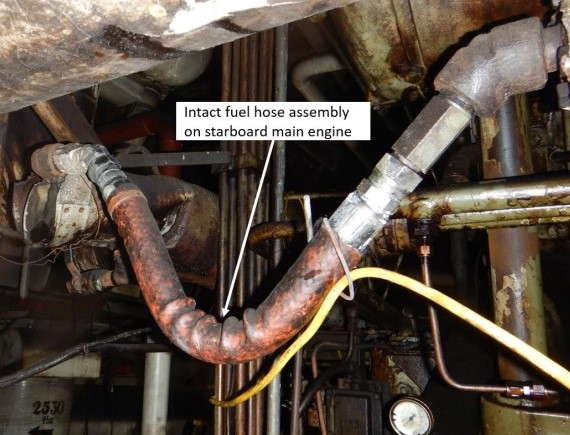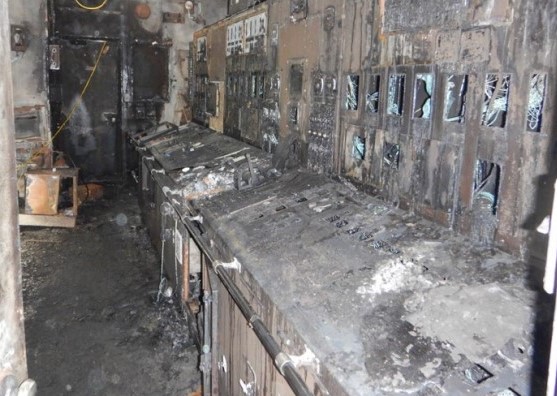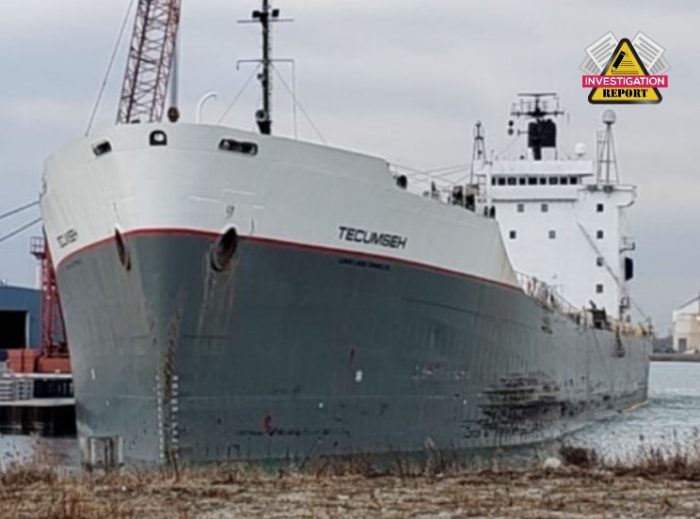The Transportation Safety Board of Canada (TSB) published its report on the 15 December 2019, involving the bulk carrier Tecumseh, that had a fire in the engine room while transiting the Detroit River off Windsor, Ontario.
The incident
On 13 December 2019, the Tecumseh departed Thunder Bay, Ontario, for Windsor, Ontario, loaded with 19 667 tonnes of canola seed in bulk. By 15 December at 1343, 4 the Tecumseh was downbound in the Detroit River, passing the Ambassador Bridge, which connects Detroit, Michigan, U.S., with Windsor. The bridge team consisted of the master, a helmsman, and the second officer. The engine room team consisted of the third engineer and an engineering assistant.
At 1406, the engineering assistant was carrying out a routine round of the engine room and the third engineer was re-entering the engine room from the steering gear flat when they both observed that a fire had ignited near the port main engine. They immediately proceeded to the ECR, where the third engineer called the bridge and reported the fire to the master. At the same time, the fire detection system sounded in the engine room and on the bridge panels. Thick smoke rapidly developed in the engine room, and the third engineer and the engineering assistant evacuated the engine room.
The master immediately sounded the general alarm, used the vessel’s public address system to instruct all crew members to muster, and ordered the helmsman to alter the Tecumseh’s course toward the Canadian side of the river. As none of the crew assigned to muster in the ECR could proceed to the engine room due to the dense smoke, all crew, with the exception of the bridge team, proceeded to the muster station on the main deck aft of the superstructure.
Concurrently, the master used the vessel’s very high frequency (VHF) radiotelephone to report the emergency to Marine Communications and Traffic Services (MCTS) in Sarnia, Ontario. The Canadian Coast Guard (CCG) vessel Limnos was put on stand-by through the Joint Rescue Coordination Centre (JRCC) in Trenton, Ontario. At 1411, the Tecumseh anchored near the Morterm Ltd. terminal in the Port of Windsor (Appendix A). The master then shut down both main engines from the bridge.
At 1412, crew members had mustered on the main deck with their lifejackets and survival suits. All 16 crew members were accounted for.

The master ordered the crew to proceed with their assigned duties per the vessel’s muster list. Two of the deckhands went to retrieve the firefighter outfits, and other crew members began closing the engine room’s ventilation fire dampers. The master and the chief engineer conferred, using the internal telephone system, and decided to use the engine room’s carbon dioxide (CO2) fixed fire suppression system.
The chief engineer proceeded to the system’s remote release station, located on the main deck adjacent to the engine room door, and immediately activated the release of the CO2 in the engine room. The chief engineer then went to the emergency control station on deck C, where he used the engine room’s remote controls to activate the quick-closing valves on the fuel oil supply, stop the ventilation fans, and stop all the oil-handling equipment.
He also started the emergency generator and the emergency fire pump. A few minutes later, the vessel’s auxiliary generators stopped, and only essential equipment powered by the emergency generator was available.
At 1423, the master called Lower Lakes Towing Ltd. (LLT), the company that owns and manages the Tecumseh, and reported the situation. At 1429, the master reported to MCTS that the fire was under control and contained in the engine room, and that no assistance was required. Shortly afterward, the Limnos was stood down by JRCC Trenton.
At 1430, some of the crew were tasked to rig fire hoses to prepare for boundary cooling. The 2 deckhands who had retrieved the firefighter outfits were asked to don them. The deckhands stated that they had not taken Marine Emergency Duties (MED) training and therefore could not act as firefighters.
The crew attempted to start boundary cooling, but the emergency fire pump was not delivering water to the fire main line. The chief engineer attempted to enter the emergency fire pump compartment from the deck A access point to assess the situation, but dense smoke prevented him from doing so.
Analysis
#1 Engine room maintenance: Considering the critical function of propulsion machinery to the safety of a vessel and its crew, it is essential that engine room equipment and systems be well maintained and that engine room practices minimize risk. The failure of the engines or other machinery or components in the engine room may pose significant safety hazards and, in some cases, create fire risks if these failures occur near ignition sources or flammable materials.
#2 Structural fire protection: Fire pattern analysis indicated that the fire originated in the port-forward area of the lower platform around the engine. The separated fuel oil supply line sprayed fuel onto the engine and hot exhaust components, igniting the fuel. Fuel sprayed onto the engine for approximately 5 minutes, until the engine was shut down from the bridge. The fire spread aft along the electrical cable trays, through unsealed penetrations in bulkheads, finally entering the ECR. Only traces of sealant were present at the time of the occurrence, and it is likely that the sealant had been removed and not replaced in 2005 when the auxiliary generators and associated cables were replaced by a previous owner.
#3 Emergency equipment A vessel’s emergency equipment, including the emergency fire pump and emergency generator, is critical during an engine room fire. The emergency fire pump is the only pump available outside the engine room to supply water to the fire main line and to allow the crew to suppress the fire and carry out boundary cooling. The emergency generator is essential during shipboard emergencies because it supplies power for the emergency fire pump and for lighting so that the crew can respond adequately. Transport Canada has recognized the importance of keeping sufficient reserves in the fuel oil tank for an emergency generator and has regulated a minimum run time to ensure that power from the emergency switchboard is available for the duration of the emergency.
#4 Safety management systems: Safety management requires all organizations to be cognizant of the risks involved in their operations and to competently manage those risks. An effective SMS can help to ensure that members at all levels of an organization have the knowledge and the tools to manage risk effectively, as well as the necessary information to make sound decisions in any operating condition, including both routine and emergency operations.
#5 Voyage data recorder: In this occurrence, the Tecumseh did not have a VDR on board, nor was one required by regulation. Consequently, investigators could not confirm engine orders and the timing of emergency response actions, or gain a complete picture of internal and external communications.

Probable cause
The investigation determined that the fire on board the Tecumseh originated on the port main engine after a flexible fuel hose assembly supplying fuel to the main engine failed.
The analysis will examine engine room maintenance, the effectiveness of the vessel’s structural fire protection and emergency equipment, and the decision to re-enter the engine room after the fire had been initially suppressed by the carbon dioxide (CO2) fixed fire suppression system.
The analysis will also look at Lower Lakes Towing Ltd.’s (LLT) safety management system (SMS), the fire response by external resources, and the value of voyage data recorders.
Findings as to causes and contributing factors:
- A fuel hose assembly of unknown origin and integrity failed on the port main engine, which allowed fuel oil to spray on to local sources of ignition, leading to the fire.
- Multiple unsealed deck cable penetrations between the engine room and the engine control room (ECR) deck allowed the fire to propagate to the ECR main switchboard, leading to the complete destruction of the ECR.
- Because the maintenance opening for the emergency fire pump compartment was not secured, smoke entered the emergency fire pump compartment and prevented the crew from being able to access the fire pump to troubleshoot it. Consequently, for approximately 2 hours, the fire pump was unavailable to the crew for boundary cooling.
- Approximately 3 hours after the CO2 was released, crew re-entered the engine room from the steering gear flat with a charged fire hose. Re-entry into the engine room allowed fresh air to enter the engine room, which most likely re-ignited the fire.
- Without local shore-based firefighting resources to assist, the vessel was forced to await the arrival of additional firefighting resources, which meant that the fire burned for many hours without on-board firefighting capability.
Findings as to risk:
- If vessel maintenance and machinery monitoring do not ensure that propulsion machinery remains reliable, there is a risk of damage to the vessel and the environment and of injuries to personnel should a failure occur.
- If the integrity of structural fire protection is compromised and emergency equipment does not operate reliably during a fire, there is a risk that fire prevention, control, and extinguishing efforts will be hindered.
- If recurrent Marine Emergency Duties training is not required, there is a risk that crew members will not maintain their skills nor be up to date with current knowledge and practices for handling emergencies.
- If training, instructions, and emergency drills for fire response are inadequate or missing, there is a risk that the crew will be unable to respond effectively to a shipboard fire.
- If key components of a safety management system, such as the reporting of nonconformities and the assessment of associated risks, are not implemented by companies and crews, there is a risk that the safety of the crew, the vessel, and the environment will be compromised.
- If shore-based fire brigades expected to support on-board firefighting do not receive appropriate training and do not carry the proper equipment, these brigades will have limited ability to support crews fighting shipboard fires, putting crew, the general public, property, and the environment at risk.
- If data from voyage data recorders are not available to an investigation, it may not be possible to identify and communicate safety deficiencies to advance transportation safety.

































































